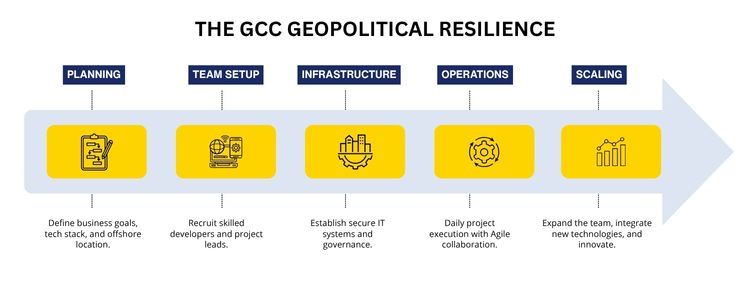
To deal with the competitive global technological world, companies are using distributed scaling models. The core of this strategy is the Offshore Development Center (ODC). An Offshore Delivery Center is a remote team of technology experts working in a foreign nation, like India, which is specifically created to serve as a fully operational part of the Research and Development (R&D) and product division of the client organisation based in their home country. An ODC is not just any project-based vendor; it is fully controlled by the overall strategy of the client and fully in line with the internal processes and organisational culture of the client. A United States-based SaaS firm is about to open an ODC in Bengaluru, India, for its growth and a strong domestic rivalry concerning specialised AI talent. This facility would employ senior Data Scientists and MLOps Engineers. The only requirement of this team is to speed up the creation of the complex functions of the core platform, and it is directly under the strategic supervision of the US R&D leadership. Such an arrangement of a company turns the ODC into a long-term Offshore Capability Centre, which is designed to be innovative.
The conventional approach of in-house growth is already growing with the rising domestic pay and fierce contest of niche abilities. This has led to a significant investment in the global model due to pressure. The market for Offshore Software Development valued at $122 billion in 2024, is assured to grow to $283 billion in 2031, with a strong Compound Annual Growth Rate (CAGR) of 10.13%. This development attests that adoption of an advanced Offshore Development Strategy is the ultimate blueprint towards competitive, future-orientated scaling. In this strategic model, India has become the world nexus. It is considered to have reached the point of the story where it is no longer just a matter of cost arbitrage; these days it is the richness of talent and the innovation ecosystem that has now been established. This change is evident in the setting up of more than 1,900 Global Capability Centers (GCCs) that are already in operation in India, and the numbers are likely to increase. ODC, thus, is creating an Offshore Capability Center that creates transformative value and is long-term.
The choice to locate an Offshore Software Center in India provides an impressive two-fold axial benefit which can be matched with no other locale: a vital shortage of talent and a deep financial prowess. Global Talent Crunch Reduction India is an exception to the global technology industry, as it projects a labour-skills shortage of around 4.3 million workers in the next decade (2030). The high-skilled, educated workforce and proactive skill training programmes have made India uniquely poised to experience a skilled-labour supply of around 245.3 million employees by 2030. The large talent pool would mean that senior architects, experts in Data Sciences, and MLOps Engineers are readily available to organisations, which are known to be highly rare in Western markets. T The company’s ability to hire top talent quickly and in large quantities is a direct result of addressing the talent shortage, which poses the greatest threat to product roadmaps. Financial Prudence And 24/7 Velocity. The economic returns of the involvement in the Indian ecosystem are high, and the companies can achieve a 40-70 per cent reduction of the total development expenses relative to employing the same staff at home. Such savings are achieved through cost reduction to the fixed operating overheads of the infrastructure, localised benefits and recruitment fees that have the potential to increase the Total Cost of Ownership (TCO) of in-house employees. The freed-up capital can be reinvested strategically either in core product innovation or expansion. Moreover, the time zone of India has made the development model of follow-the-sun (FTS) highly effective. This consistent, 24/7 productivity is attained by passing the work artefacts at the end of the day. This 24-hour cycle radically shrinks the development lifecycle and increases the time to market new features at an accelerated pace and cost and provides a vital competitive advantage.
It takes a disciplined and trust-based approach to leverage an ODC. It should be concerned with extreme vetting and extensive integration of operations to reduce risks of global distribution.
Making a decision to implement an offshore development center is a commitment to a high-velocity operating model to distribute globally. The strategic competitive edge is not to identify the lowest cost of resources but the finest talent and capability in the world. Organisations can transcend domestic scaling by taking advantage of the abundant talent overflow of India and the existing landscape of the capability centers.
The Offshore Development Strategy converts the fixed operational expenses into strategic growth capital, and your company would be at the forefront of the next stage of digital growth. Now it is the right moment to entrench your Offshore Development Strategy and establish your global capability centers.
A GCC is an offshore facility of a multinational company that undertakes niche roles such as research and development, information technology service and strategic management. It is a government program that gives the women entrepreneurs up to 1 crore in bank loans to fund greenfield projects. Personal responsibilities and unconscious bias are the factors that lead to their mid-career attrition and slow them down in their careers. They introduce new ideas, understanding, and team-oriented leadership that speeds up the advancement of such areas as AI and cybersecurity. By 2030, women are expected to take up 25-30 per cent of GCC leadership positions, which will be paramount to the growth of the Indian market. Aditi, with a strong background in forensic science and biotechnology, brings an innovative scientific perspective to her work. Her expertise spans research, analytics, and strategic advisory in consulting and GCC environments. She has published numerous research papers and articles. A versatile writer in both technical and creative domains, Aditi excels at translating complex subjects into compelling insights. Which she aligns seamlessly with consulting, advisory domain, and GCC operations. Her ability to bridge science, business, and storytelling positions her as a strategic thinker who can drive data-informed decision-making.
Market Validation and Global Reliance
The India Advantage is The Core Value Proposition

Roadmap to Seamless Integration
Phase
Strategic Focus
Critical Action Points
Governance Mandate
Foundation & Scope
Alignment & Team Structure
Define the initial Minimum Viable Team (MVT) (e.g., 3-5 roles) and core project scope.
Select talent for niche expertise and cultural compatibility.
Vetting & Compliance
Risk Mitigation
Mandate vendors holding ISO/IEC 27001 certification to ensure mature data security management.
Developed contracts need to clearly establish the ownership of Intellectual Property (IP) and strict NDAs
Integration & Process
Operational Unity
Use a single toolchain
Determine comprehensive documentation guidelines to facilitate the smooth transfer of information and prevent coordination issues.
Future-Proofing
Capability Growth
Incorporate offshore architects in strategic R&D and invest in everlasting upskilling.
Measure the performance with objective performance indicators such as Agile velocity charts to measure the workloads and productivity.
Conclusion
frequently asked questions (FAQs)

Aditi
Hey, like this? Why not share it with a buddy?
Related Posts
Recent Blog / Post
- Gurugram’s Tech Ascent: Decoding the New Haryana GCC Policy October 15, 2025
- Scaling Your Tech Team: A Beginner’s Look at the Offshore Development Center October 15, 2025
- Agile Methodologies for GCCs: A Blueprint for Success October 6, 2025
- The Legal and Compliance Checklist for a New GCC Setup October 4, 2025
- The Rise of Niche GCCs: A Focus on Specialised Capabilities October 4, 2025
- The Impact of Regulatory Changes on GCC Operations October 4, 2025
- Cybersecurity for GCCs: A Proactive Approach to Data Protection September 30, 2025
- Beyond Cost: Measuring the True ROI of Your GCC Investment September 29, 2025
- The Future of GCCs in the Retail Sector: A Strategic Playbook September 29, 2025
- David vs Goliath: Mid-Sized GCCs Quietly Outperform the Big Brands September 29, 2025
- Infineon’s Big Bet on India: Inside Its First GCC in GIFT City September 29, 2025
- From Campuses to Capability Centres: How Indian Universities Power the Global GCC Ecosystem September 29, 2025
- Retail Meets Digital: Costco’s GCC in Hyderabad Marks a Global Shift September 29, 2025
- The Silent Crisis: Why Many GCCs Plateau After 3 Years and How to Avoid It September 24, 2025
- Germany’s New Skilled Immigration Act and Its Ripple Effect on the GCC Talent Model September 24, 2025
















